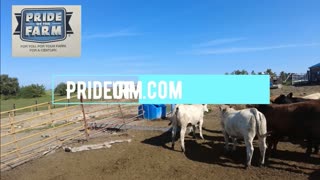Premium Only Content

Intriguing Insights into Reindeer - Information and Characteristics
The reindeer, scientifically known as Rangifer tarandus, is a remarkable and highly adapted species of deer that thrives in the extreme northern regions of the world. Revered for its role in folklore, indigenous cultures, and as a symbol of the holiday season, the reindeer is a true marvel of nature. Here is a description of this majestic Arctic icon:
Physical Characteristics:
Antlers: Male reindeer, known as bulls, and some females, called cows, sport impressive antlers that can span up to 4 feet (1.2 meters) in width. These antlers are deciduous, meaning they shed and regrow annually. They are used for various purposes, including defending territory and attracting mates.
Hooves: Reindeer have specialized hooves designed for cold, snowy environments. They are broad and concave, acting as natural snowshoes, allowing them to walk on snow without sinking.
Fur: To withstand the harsh Arctic climate, reindeer possess a dense double-layered coat. The outer layer is made up of coarse, hollow hairs that trap air and provide insulation, while the inner layer is soft and warm.
Habitat and Range:
Arctic and Subarctic: Reindeer are found primarily in the Arctic and subarctic regions of North America, Europe, and Asia. They inhabit tundra, boreal forests, and alpine environments, where they have evolved to thrive in cold and snowy conditions.
Migration: Some reindeer populations are known for their long-distance migrations, covering hundreds of miles in search of food and avoiding harsh winter conditions. This nomadic lifestyle is essential for their survival.
Behavior and Lifestyle:
Herding: Reindeer are social animals and are often found in herds that can range in size from a few individuals to several thousand. This herding behavior helps protect them from predators like wolves and bears.
Diet: Reindeer are herbivores, primarily feeding on lichens, mosses, grasses, and shrubs. They are particularly adapted to dig through snow to reach their preferred food source, which includes lichen found beneath the snow cover.
Vocalizations: Reindeer communicate with various vocalizations, including grunts, snorts, and alarm calls. These sounds help maintain social bonds within the herd and alert others to potential dangers.
Cultural Significance:
Reindeer Herding: Indigenous peoples, such as the Sámi of Scandinavia and the Nenets of Russia, have relied on reindeer herding for centuries as a source of sustenance, transportation, and cultural identity.
Folklore and Santa Claus: Reindeer have captured the imagination of people worldwide as Santa Claus's trusted sleigh-pullers, thanks to Clement Clarke Moore's poem "A Visit from St. Nicholas" and other holiday traditions. Names like Rudolph, Dasher, and Dancer have become household names associated with Christmas.
Conservation Status:
Vulnerable Populations: Some reindeer populations face conservation challenges due to habitat loss, climate change, and disturbance from human activities. Conservation efforts are underway to protect and preserve these remarkable creatures and their habitats.
In summary, the reindeer is a captivating symbol of the Arctic wilderness, celebrated for its resilience, cultural importance, and association with holiday traditions. These majestic animals embody the spirit of the extreme northern regions they call home and continue to captivate people around the world with their enduring charm and adaptability.
-
 LIVE
LIVE
Chad Prather
14 hours agoThe Gospel That Can’t Save You: Exposing the Lie of Self-Help Christianity
4,447 watching -
 LIVE
LIVE
The Chris Salcedo Show
11 hours agoAfter What They've Done, Mockery Is The Best They Deserve
725 watching -
 2:57:12
2:57:12
TimcastIRL
12 hours agoDems SHUTDOWN Government For NO KINGS Insurrection, Block Police Pay | Timcast IRL
474K157 -
 12:35
12:35
Adam Something
4 days agoTesla Cybertruck: A Tragedy On Four Wheels
11.6K7 -
 8:22
8:22
Silver Dragons
18 hours agoAre Silver Rounds Really the BEST SILVER to Stack Right Now?
3.16K9 -
 19:52
19:52
Neil McCoy-Ward
19 hours ago🚨 The Global Financial Collapse May Have Already Started 🔥
10.9K3 -
 LIVE
LIVE
BEK TV
23 hours agoTrent Loos in the Morning - 10/14/2025
88 watching -
 10:12
10:12
Ken LaCorte: Elephants in Rooms
17 hours ago $0.39 earnedIt's not just about intelligence
10.5K3 -
 1:43
1:43
NAG Daily
15 hours agoNEWS HEADLINES FOR DUMMIES W/GREENMAN REPORTS
8.64K -
 26:48
26:48
Anthony Rogers
14 hours agoCandlebox Interview — Daytona Speedway
2.29K1